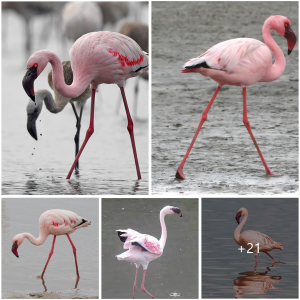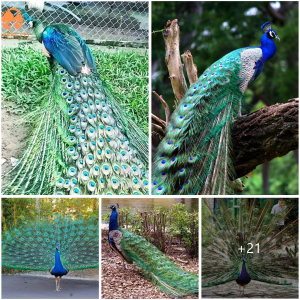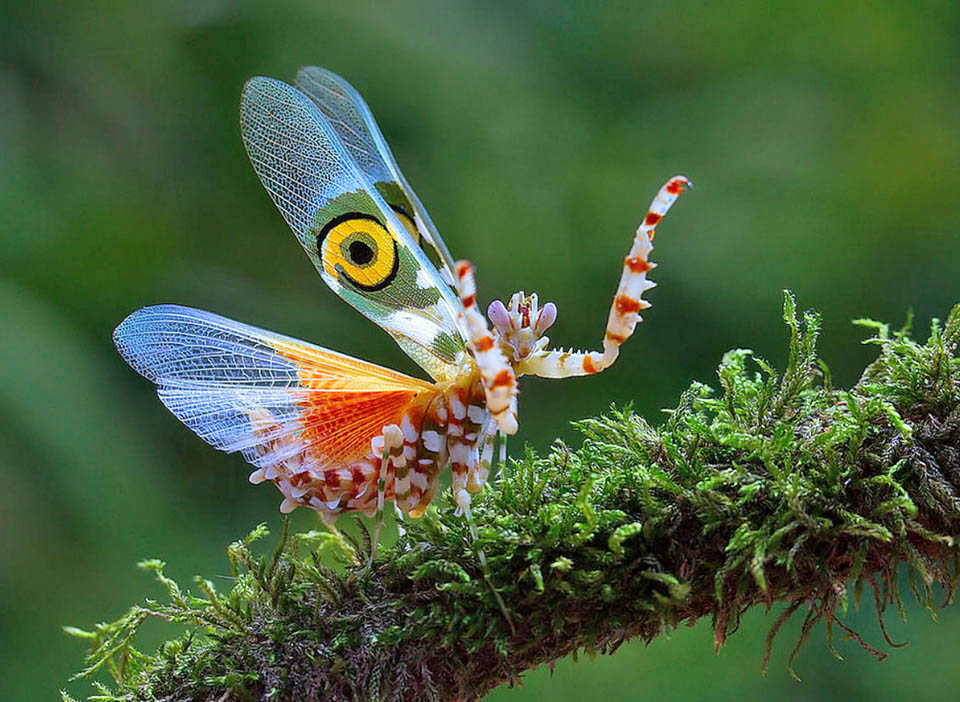
Pseudocreobotra wahlberghii is a small African tropical mantis. Because of its colourful beauty, it is called Spiny flower mantis. The adult who fears a threat assumes a terrifying look, raises the head, the prothorax and the fore legs, as well as the forewings evidencing the ocellar spots that recall the number 6 or 9 © Jimmy Hoffman
The Spiny flower mantis (Pseudocreobotra wahlbergii Stål, 1871) is a species belonging to the order Mantodea, whose showy livery recalls that of the Asian species of the genus Creobroter Westwood, 1889.
The order is believed to be cognate to the Blattaria and Isoptera with whom it shares the asymmetry of the male reproductive system and the reduction of the ovipositor. This subset of insects Polineotteri, equipped with numerous veins in the wings, and of Orthopterida with straight wings, is indicated as Dictyoptera because the wings have a reticulum of secondary alar veins that recalls the fishing nets from the old Greek “δίκτυον” (dictyo), that is, net.
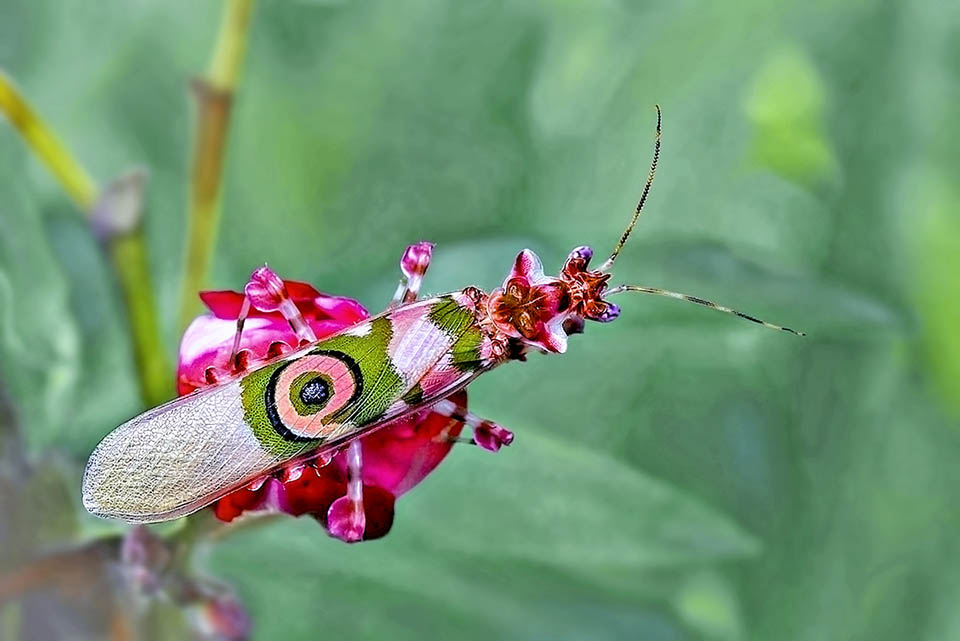
The females, little larger than the males, often stop camouflaged on the flowers or the surroundings to seize insects attracted by the colour and scent © Jimmy Hoffman
The term Mantodea, with the meaning of prophet, refers to the posture that the individuals assume when resting, when they fold up their robust raptatory fore legs in an apparently mystical position. Actually, they are formidable predators in ambush.
The name of the genus Pseudocreobotra is composed by Pseudo from the Greek “ψευδής” (pseudés) false, similar, and creobotra coming in its turn from “κρέας” (kreas), meat, and “βρωτήρ” (broter), devourer, eater (carnivore), hence the genus Creobroter. The generic name therefore means that it is a fake Creobroter. It resembles the species of this genus, but it is not; whilst the specific name wahlbergii, of Wahlberg in Latin, honours the memory of Johan August Wahlberg (1810-1856), Swedish naturalist and explorer.
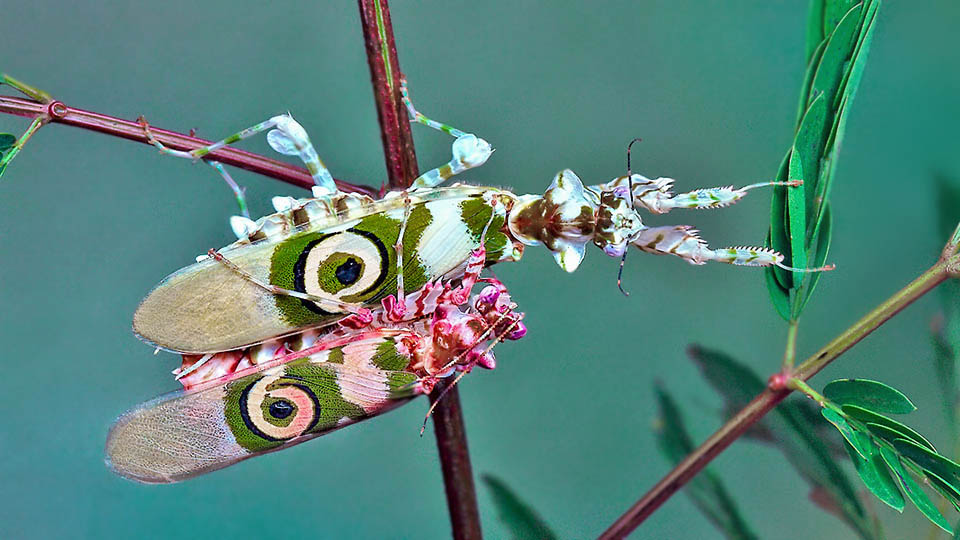
To reproduce the male approaches cautiously the always available female, ready as it is to secure a meal © Jimmy Hoffman
To the Mantodea belong about 2400 terricolous species of dimensions varying from 2,5 to 16 cm. The body is elongated, with frequent homochromy, in many exotic species the coloured liveries reinforce the effect of the terrifying attitude they take to drive away the competitors.
The head is small, mobile with developed compound eyes and three ocelli; the antennae are more or less long and filiform.
The mouthpart is masticatory with short, strong and slightly asymmetric mandibles.
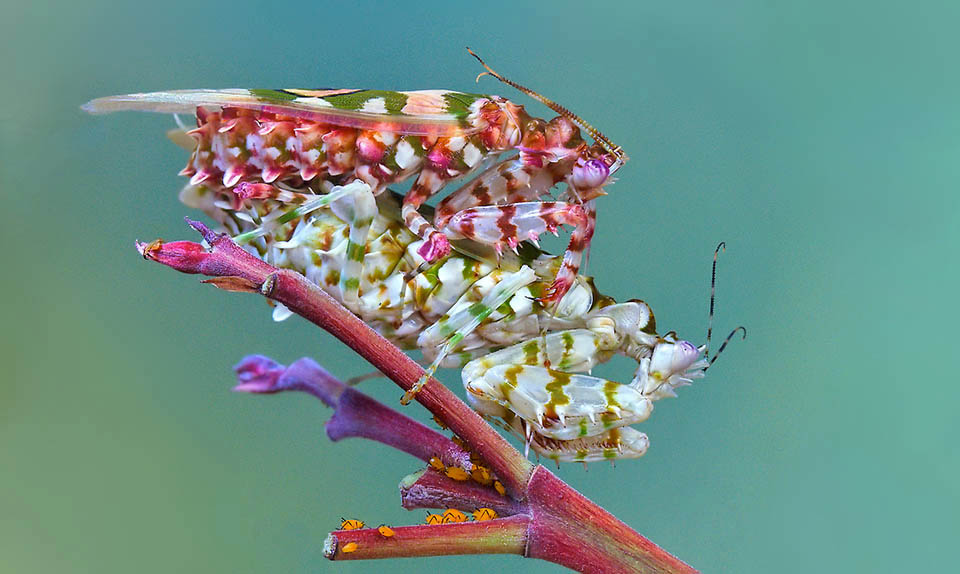
It often rises on the back of the partner and stays there long out of reach of its terrible raptatory legs. Only a second time the mating takes place lasting for hours. The female devours often the companion starting from the head that might block the mating. The male is fully exploited in the interest of the species © Jimmy Hoffman
The first segment of the thorax is longer than the others; in many species it is narrow, in others laterally expanded. The forewings are narrower and more sclerified than the hindwings, reduced in some species. The abdomen is flattened and wide with two terminal cerci the females utilize for building the oothecas. The male copulatory organ is asymmetric.
The majority of species, diffused in the warm and temperate zones, has a diurnal activity; some are attracted by the night lights.
Zoogeography

From the about 4 cm long egg-layings get out the neanids that at once get free from the membrane that protected them during the exit © Jimmy Hoffman
Pseudocreobotra wahlbergii is native to southern and eastern Africa where it is very common together with the congener Pseudocreobotra ocellata. Due to the facility with which it is possible to grow it in terraria, it is traded in various countries for amateur purposes.
Ecology-Habitat
The Spiny flower mantis lives in environments where the day temperatures fluctuate from 25 to 30 °C and the night ones do not go below the 18 °C with a humidity of around 60%.
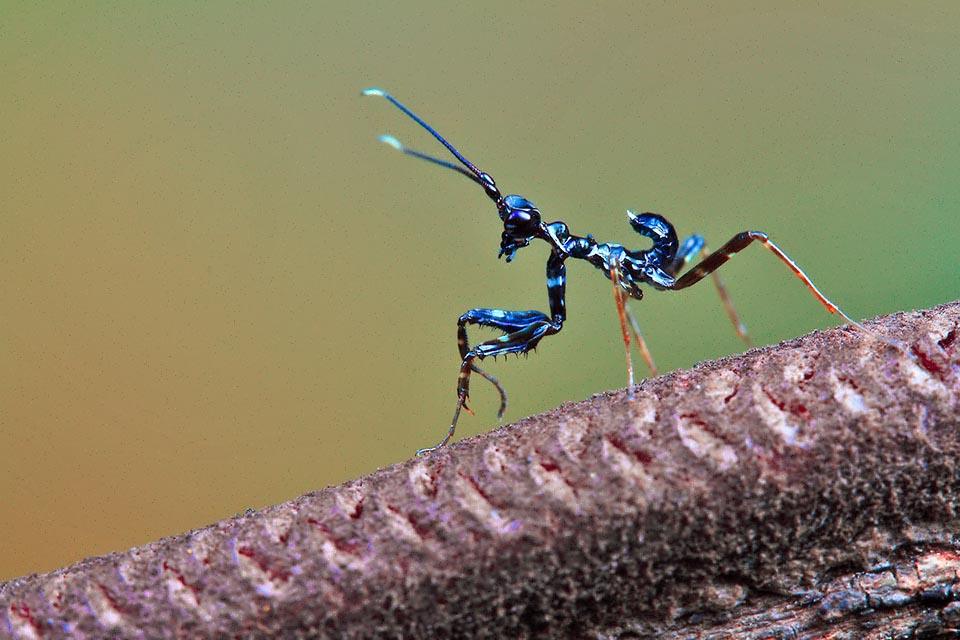
Here is an egg-laying. The first age neanids body, already similar to the adults one, is of dark colour © Jimmy Hoffman
During the day the active stages keep motionless in ambush or swing rhythmically on leaves, flowers and branchlets of herbaceous or bushy plants on which they climb thanks to the nails of the forelegs, ready to seize the preys represented mainly by Dipterans and other flying insects.
Morphophysiology
The body of the adults is of typically white or pale green colour, but can be yellowish, pink or reddish depending on the environment where they live.
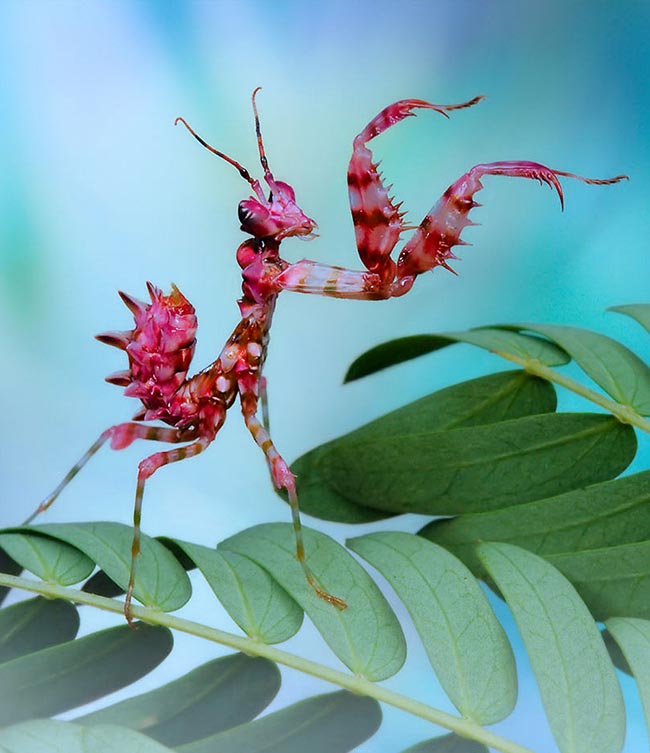
In next ages teguments gets clearer and assumes always paler colours depending on the surrounding environment © Jimmy Hoffman
The females are about 5 cm long.
The males are smaller but their antennae are longer.
The wings of the females are longer and are equipped with small spines at the base, absent in the males.
On each one of the coriaceous forewings, called tegmona, is present a spiral ocellar spot that reminds the number 6 or 9, of black or yellowish green colour, contoured by green.
The rear wings are membranaceous, with the basal part of yellow colour, whilst, conversely, in the congener Pseudocreobotra ocellata they are totally hyaline.
This character allows us to distinguish the two species.
The forelegs are raptatory; the first article (coxa) is big, followed by the short trochanter.
The femur is long and pointed, equipped in the lower part with numerous spines arranged on 3 rows.
In the inner side is present a brush the insect utilizes, after having moistened it with its saliva, for cleaning the head and the compound eyes.
The long tibia is equipped with spines along the lower margin.
When they come close to the femur, the spines come in close contact and clench the prey.
The middle legs and the hind iones are ambulatory and have fleshy adhesive pads that allow the insect to climb even smooth surfaces.
The abdomen of the females displays seven apparent segments, whilst in the males they are eight.
From the egg-laying get out the neanids wrapped by a thin membrane that protects them on the way out. When just born the body is more or less dark. In the subsequent ages this becomes clearer and clearer to finally assume the colour of the adult.
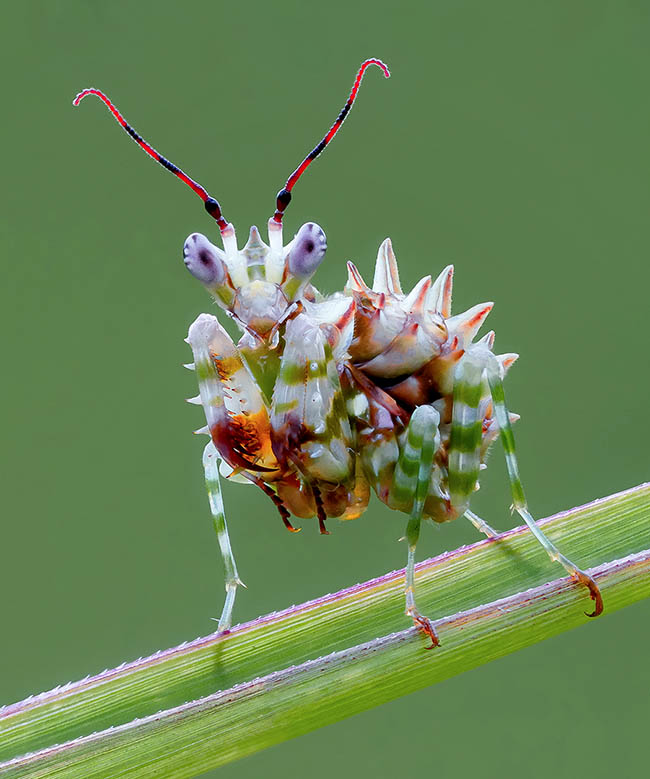
This male at the last nymphal stage, wings apart, has almost the adult’s size © André De Kesel
The nymphal stages following them can be recognized for the presence of the alar outlines and of the ocellar spot on the dorsal part of the abdomen similar to that of the wings of the adult.
Ethology-Reproductive Biology
If the individuals are disturbed or they fear a threat often they do not go away but they react by raising their head and the prothorax spreading the forelegs apart.
And, more, if it’s not enough, the adults raise at the same time the forewings showing the ocellar spots.
Normally, they camouflage with the flowers near which they stop to ambush the anthophilous insects who are attracted by the colour and the scent.
The prey accessible to the neanids are small Thysanopterans, Aphids and Leafhoppers.
The nymphs and the adults mainly catch Dipterans, Hymenopterans and spiders.
The females become adults after having performed seven moults, whilst the males do six of them.
The females, like those of other mantises, practice the so-called sexual cannibalism, consisting in devouring the male during the mating.
The female begins attacking it on the head where is located the brain that presides over and regulates all the activities including that of the peripheral nerve ganglia from which also depends the duration of the mating.
Without the blocking action of the brain the ganglion continues to send impulses to the sexual organs that prolong the mating until the male gonads are emptied and this allow the male to fecundate a greater number of eggs ensuring a bigger number of descendants.
The female, after having taken the nutrient proteins of the first male useful for maturing other eggs, can mate with other males that might suffer the same fate.
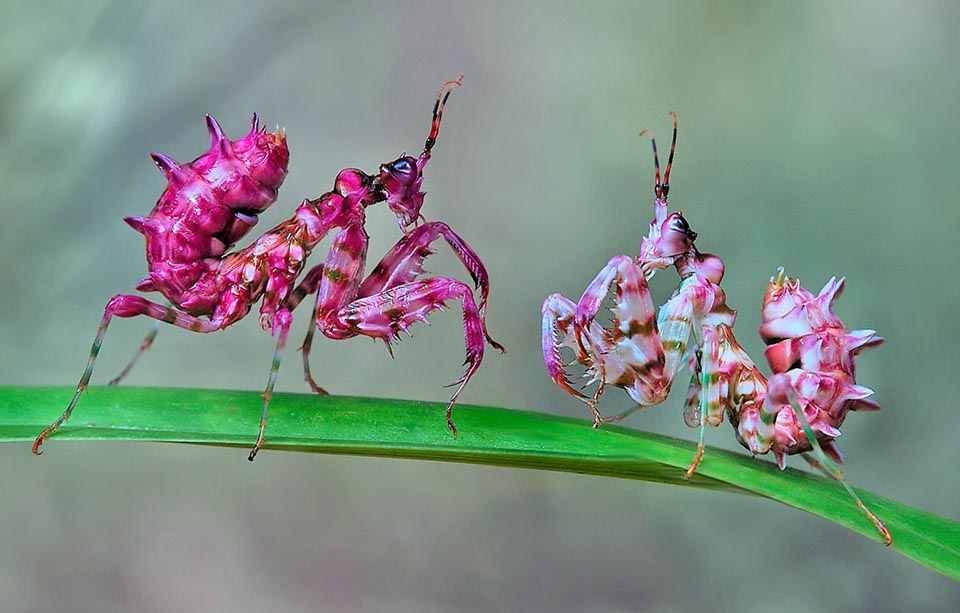
The chromatic variability is notable. Here are two female nymphs who while meeting intimidate each other displaying the usual terrific posture © Jimmy Hoffman
Despite the risks the males approach the females and cautiously carry themselves on the back of the partner, on which they stay for some time before trying the mating.
The fecundated females oviposit on the branches of the plants where they live ambushing the preys.
The cylindrical ootheca is about 4 cm long. In order to create it, from the vulvar opening together with the eggs also gets out a secretion that forms a soft foam thanks to the mechanical action of the valvae of the outer female genitals that move rhythmically.
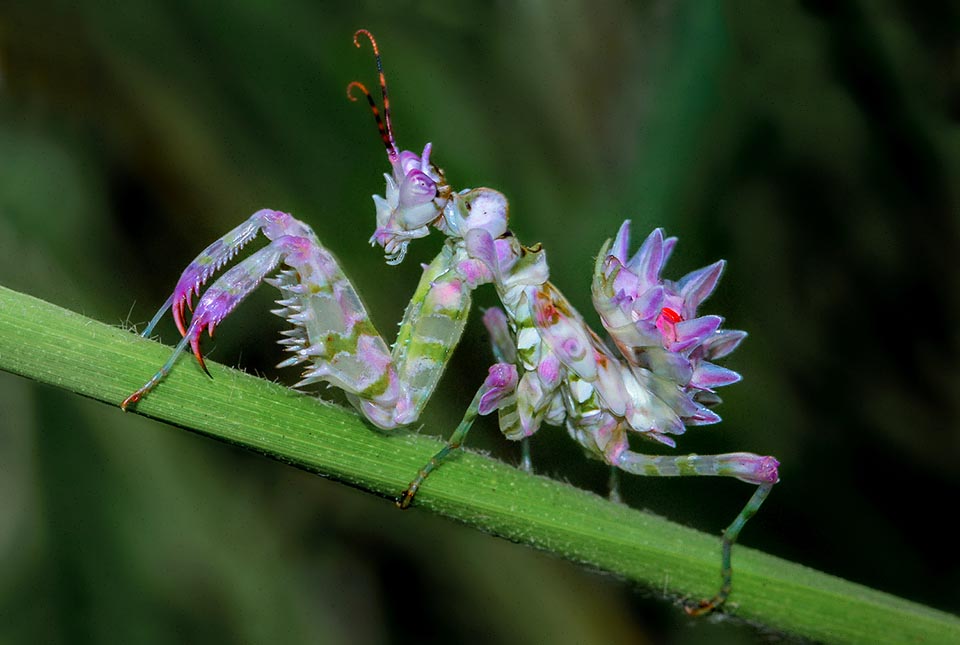
This nymph displays on the wing outlines the future ocellar spot. The fore raptatory legs are already equipped with spines like the adults © Bart Wursten
The elongated shape is due to the fact that the female advances slowly while releasing the foam that incorporates and isolates the eggs.
From the ootheca whose outer part gets rapidly hard, after 30-40 days of incubation come to life the newborn neanids that remain gregarious for some days before dispersing while looking for prey. They will reach the adult stage in about 3 months.
In nature Pseudocreobotra wahlbergii has numerous foes: the newly born neanids are eaten by the ants, whilst the subsequent stages are predated by amphibians, reptiles, birds and mammals.


